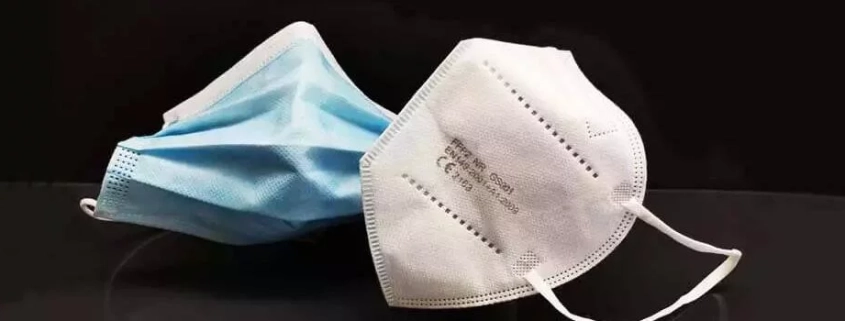FFP2 Mask against coronavirus
At the beginning of 2021, FFP2 mask is becoming increasingly popular in the fight against the spread of Covid-19 . This air-purifying respiratory protective equipment that provides a high level of protection is still not well known to the general public. We are evaluating this type of mask and its use in the face of the coronavirus outbreak.
Covid-19 and FFP2 mask
Faced with Covid-19 and its more contagious variants, health authorities in different countries have taken action to limit the increased risk of transmission. FFP2 leans towards wearing masks. In Austria, they have now become mandatory in transportation, shops and service places. Germany has also made wearing this type of protective mask mandatory.
In France, the Supreme Council of Public Health recommends the wearing of high-performance category 1 disposable masks (according to standard EN 14683) for the general public. At the same time, HCPH recommends that the FFP2 mask be used only for healthcare personnel performing invasive procedures and performing manipulations of the respiratory tract.
What is an FFP2 mask?
Surgical mask VS FFP2 mask
FFP2 mask in combating the Sars-CoV-2 epidemic To understand why it is popular, it is necessary to understand the difference between a surgical mask and respiratory protective masks in the FFP category.
Surgical masks that meet the NF EN 14683 standard are, as the name suggests, primarily designed for medical use. Depending on their type (I, II or IIR), they prevent the spread of droplets but they do not prevent inhalation of aerosols (very fine particles suspended in the air). However, through aerosols Risk of infection with Covid-19 It is important. It is one of three modes of transmission of Sars-CoV-2 (others include: contact with respiratory droplets, respiratory secretions, coughing and sneezing, and contact with an infected person or surface).
Respiratory protection masks classified as FFP according to NF EN 149 standard, It is designed to protect against the finest particles found in the ambient air, especially aerosols. They are therefore currently valuable to prevent Covid-19 contamination as much as possible.
FFP2 protection
Designed with multi-layer innovative filtering materials disposable FFP2 masks It is easy to use, affordable and provides protection against viral particles such as Covid-19.
FFP2 mask with an infiltration rate of less than 8% It is a respiratory protection that filters at least 94% of aerosols. It is a respiratory protection mask that is widely used in many environments and complies with the NF EN 149 standard ( American N95 mask or similar to KN95 for South Korea). Outside of the medical environment, this PPE (personal protective equipment) is used in various industries for woodworking, metalworking or waste disposal. Indeed, FFP2 protection provides a high level of security against various elements such as droplets and aerosols from very fine wood, metal particles, welding fumes, paint, varnish and viruses.
FFP (For Filtering Face Particles) protection are available as disposable masks but are also available as gas mask filters. For example, combination filter cartridges such as A2-P3 protect against organic and inorganic gases and vapors and solid and liquid microparticles with boiling points above 65°.
Contrary to popular belief, a FFP2 PPE does not always take the form of a duckbill mask . In fact, the FFP2 qualification depends not on its shape, but on the level of protection against particles and aerosols. The FFP2 level of protection can be attributed to many types and forms of equipment. A duckbill, shell, medical, consumer, disposable, reusable or dustproof mask can achieve this qualification. The same applies to other filtered respiratory protection equipment, such as full gas masks or powered air-purifying respirators, which can be equipped with anti-particle protection filters up to FFP3 level.
Some FFP2 masks can be equipped with an exhalation valve . Wearing non-powered air cleaning (filtering) respiratory protective equipment requires a respiratory effort proportional to the level of protection of the equipment. Therefore, a valveless FFP2 mask contains resistance during inhalation and exhalation. No matter which mask shape you choose, the exhalation valve will allow exhaled air to escape more easily. Therefore, this PPE with valve provides great comfort to the user . For this reason, respiratory protection with integrated valves is generally more popular for tough jobs (sanding, spray painting, etc.).
Which FFP2 mask for Covid-19 protection?
To optimize the use of this PPE, which is important for optimal protection against Covid-19 is to choose a mask shape that fits the face properly. At the same time, for maximum protection disposable FFP2 masks should be preferred and replaced regularly.
Finally, wearing valved PPE provides genuine comfort and remains an effective protection solution for the wearer, but is likely to allow aerosols emitted by the wearer to escape into the ambient air.
Should I choose FFP3 mask?
FFP3 mask, Provides respiratory protection that filters at least 99% of aerosol with less than 2% inward leakage. This type of equipment is maximum protection level creates . The use of an FFP3 mask as protection against respiratory Covid-19 contamination may seem relevant or even necessary in certain situations. However, installing this type of protection often has a significant respiratory effort It is important to remember that it is subject to Therefore, it is often difficult to wear this equipment all day without feeling uncomfortable. To solve this problem of breathing resistance when wearing an FFP3 mask, some manufacturers are expanding their research efforts and offering increasingly comfortable equipment. For example, filtration specialist GVS, with minimal breathing resistance developed the F31000 FFP3 mask, which provides maximum protection. The same goes for the manufacturer Dräger, which optimizes protection and comfort with the CoolSAFE filtration technology of its X-plore 1900 dust mask.
It should also be noted that the selected respiratory protection mask should be worn and used in accordance with the recommendations of health authorities. Whether it is a surgical, FFP2, FFP3 mask or a traditional gas mask there are many precautions that need to be taken. Moreover, while essential for optimum protection, correct fit of the mask on the face is still too often neglected.


